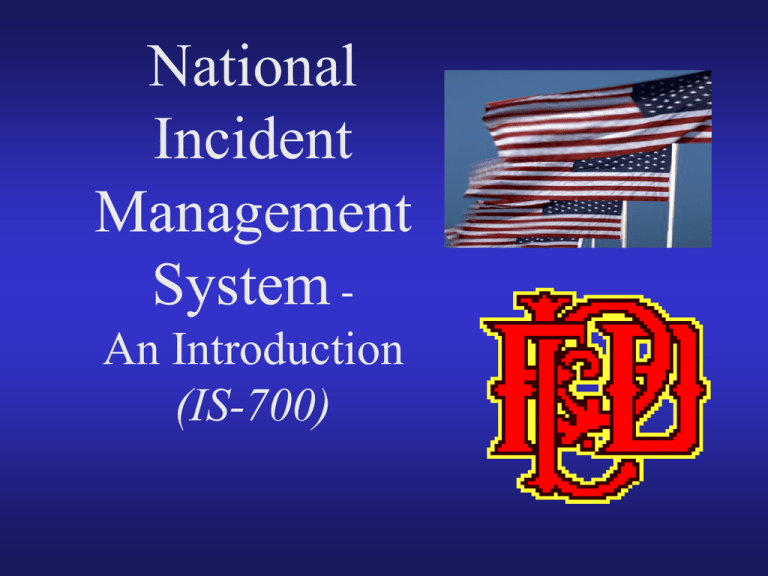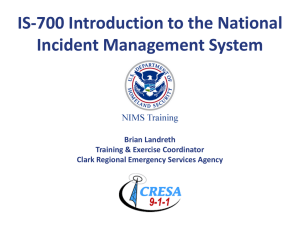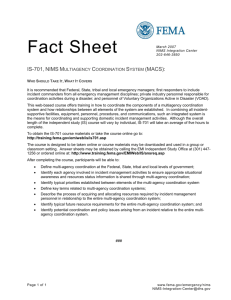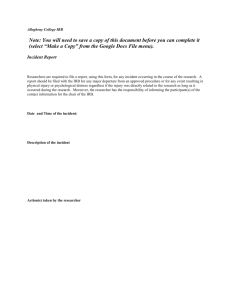National Incident Management System
advertisement

National Incident Management System An Introduction (IS-700) National Incident Management System NIMS grew out of Federal concern with the absence of an ICS that was standard across the nation. While originally ICS was the focus, NIMS soon grew into an entire emergency management organization system. NIMS is extremely similar to the California Standardized Emergency Management System (SEMS) The National Incident Management System Homeland Security Presidential Directive 5 ordered the establishment of a National Incident Management System (NIMS). NIMS provides a consistent nationwide approach for responding to all kinds of incidents – no matter what the size, scope, cause or complexity. The National Incident Management System A comprehensive, national approach to incident management • Applicable at all jurisdictional levels and across functional disciplines • Be applicable across a full spectrum of hazard scenarios • Improve coordination and cooperation between public and private entities The National Incident Management System What is the chief benefit of NIMS? • It is Applicable across jurisdictions and functions. • Used for all types of emergencies • Encourages interoperability • Enhances the ability of different classes of responders to work effectively together The National Incident Management System CONCEPTS and PRINCIPLES • NIMS provides a flexible framework that facilitates government and private entities working together to manage domestic incidents. • NIMS provides a set of standardized organizational structures, as well as requirements for processes, procedures, and systems. National Incident Management System Components NIMS is comprised of several components that work together as a system to provide a national framework for preparing for, preventing, responding to, and recovering from domestic incidents • • • • Command and Management Preparedness Resource Management • Supporting Technologies • Ongoing Management and Maintenance Communication and Information Management National Incident Management System COMPONENT 1 Incident Command And Management • NIMS employs two levels of incident management structures depending upon the nature of the incident (ICS and MACS). • NIMS requires that responses to all domestic incidents utilize a common management structure. • ICS represents organizational “best practices” and has become the standard for incident management across the country ICS is interdisciplinary and organizationally flexible to meet the needs of incidents of any kind, size or complexity. • Features of the Incident Command System ICS has several features that make it well suited to managing incidents. • • • • • • Common terminology Organizational resources Manageable Span of Control Organizational facilities Use of position titles Reliance on an Incident Action Plan (IAP) • Integrated communications • Accountability Features of the Incident Command System (2) • Common Terminology The ability to communicate within ICS is critical ICS requires the use of common terminology In addition to standard titles for facilities and positions, the use of “clear text” is essential Uncommon Terminology: “Response Branch, this is HazMat1. We are 10-24.” Common Terminology: “Response Branch, this is HazMat1. We have completed our assignment.” Features of the Incident Command System (3) • Organizational Resources Resources are “typed” with respect to capability; i.e., personnel, facilities, major equipment. • Manageable Span of Control Maintaining adequate span of control throughout the ICS organization is critical. Effective span of control may vary from three to seven. Features of the Incident Command System (4) • Organizational Facilities Common terminology is also used to: Define incident facilities Help clarify the activities that take place at a specific facility Identify organizational members at the facility Features of the Incident Command System (5) • Use of Position Titles ICS positions have distinct titles Only the Incident Commander is called “Commander” Only the heads of Sections are called “Chief” • Learning and using standard terminology helps reduce confusion between the day-to-day position occupied by an individual and his/her position at or during the incident ICS Position Titles and Organizational Levels Use of Position Titles – Supervisory Levels Organizational Level Title Incident Commander SEOC Director (Policy Chief) Command Staff Officer General Staff (Section) Chief Branch Director Division / Group Supervisor Unit Leader Strike Team / Task Force Leader ICS Relies on Incident Action Plans Reliance On An Incident Action Plan • IAPs provide a coherent means to communicate the overall incident objectives in the context of both operational and support activities. • IAPs depend on management by objectives to accomplish response tactics. • Objectives are used to: Develop and issue assignments, plans, procedures and protocols Direct efforts to attain the objectives in support of defined strategies ICS Requires Integrated Communications Integrated Communications Integrated communications include: • The “hardware systems that transfer information • Planning for the use of all available communication frequencies and resources • The procedures and processes for transferring information Accountability is a Critical ICS Feature Accountability • Effective accountability at all jurisdiction levels and within individual functional areas during an incident is essential. • To that end, ICS requires: An orderly chain of command Check-in for all responders Unity of command NIMS produces two familiar concepts but gives them new (or federal specific) meanings NIMS recommends variations in incident management. The two most common variations involve the use of: UNIFIED COMMAND AND AREA COMMAND Unified Command means grouping together many agencies with different functions UNIFIED COMMAND Multi-Agency Response UNIFIED COMMAND ( Fire, Police, EMS, Public Works ) Operations Planning Logistics Finance/ Administration Example of Unified Command: A hazardous materials spill that contaminates a nearby reservoir may require that FD, Water Authority, LEPC, Health and Environment respond to the incident. UNIFIED COMMAND How Does It Work? • • Agencies work together to: Analyze Intelligence Information Establish Objectives and Strategies for a single IAP Unified Command does not change other features of ICS Participate in the decision-making process Area Command is used to group responses to multiple incidents in the same jurisdiction or incidents with a response area that crosses jurisdictions AREA COMMAND ICP 1 ICP 2 ICP 3 An Area Command is an organization established to oversee the management of: • Multiple incidents, each being managed by an ICS of its own • Large incidents that cross jurisdictional boundaries Area Command is particularly relevant to public health emergencies because these incidents are typically not site specific and may cross jurisdictions Area Command: What does it do? The Area Command has responsibility for: • Setting overall strategy and priorities • Allocating critical resources • Ensuring proper incident management • Ensuring that objectives are met. • Ensuring that strategies are followed. Area Command: How is it organized? AREA COMMAND Planning Logistics Finance An Area Command is organized similarly to a an ICS structure, but ... Because operations are conducted on-scene, and area commands are not scene based, there is no Operations Section Multi-agency Coordinating Systems (What Are They?) MACS are a combination of resources that are integrated into a common framework for coordinating and supporting domestic incident management activities. These resources MAY include: • • • Facilities Equipment Personnel • • Procedures Communications Multi-agency Coordinating Systems (What Do They Do?) The primary functions of Multiagency Coordination Systems are to: • Support incident management policies and priorities • Facilitate logistics support and resource tracking • Coordinate incident related information • Coordinate interagency and intergovernmental issues regarding incident management policies, priorities, and strategies Multi-agency Coordinating Systems (What Do They Do?) The primary functions of Multi-agency Coordination Systems are to: • Support incident management policies and priorities • Facilitate logistics support and resource tracking • Coordinate incident related information • Coordinate interagency and intergovernmental issues regarding incident management policies, priorities, and strategies • Make resource allocation decisions based on incident management priorities Multi-agency Coordinating Systems Elements Multi-agency Coordinating Systems include EOCs and in certain multijurisdictional or complex incidents, Multi-agency Coordination Entities Emergency Operations Center • Locations from which coordination of information and resources take place. • Are typically established by the emergency management agency at the local, tribal or State levels. Multiagency Coordination Entity • Typically consist of principles from organizations with direct incident management responsibilities, or with • Significant incident management support or resource capabilities Multi-agency Coordinating Systems Elements Emergency Operations Center organization and staffing is flexible, but should include: • Coordination (Operations) • Communications (Logistics/Operations) • Resource dispatching and tracking (Logistics) • Information collection, analysis, and dissemination (Planning/Logistics) EOCs may also support multi-agency coordination and joint information activities. Multi-agency Coordinating Systems Elements Multi-agency Coordination Entity Incident Responsibilities include: • Ensuring each agency is providing necessary status information. • Establishing priorities between incidents • Acquiring and allocating required resources. • Coordinating and identifying future resource requirements. • Coordinating and resolving policy issues. • Providing strategic coordination. Multi-agency Coordinating Systems Elements Multi-agency Coordination Entity Post-incident Responsibilities Following an incident(s) MAC Entities are typically responsible for ensuring revisions are acted on and may include revisions made to: • • • Plans Procedures Communications • Staffing • Other capabilities necessary for improved incident management. National Incident Management System Public Information Officer • Advises the Incident or SEOC Command on all public information matters related to the management of the incident, including: Media and public inquiries Emergency public information and warnings Rumor monitoring and control Other functions necessary for coordinating, clearing and disseminating accurate and timely information • Establishes and operates within the parameters established for the Joint Information System (JIS) Joint Information System (JIS) • Provides an organized, integrated, and coordinated mechanism for providing information to the public in an emergency. • Key elements include: interagency coordination and integration, developing and delivering coordinated messages, and support for decision-makers. • Includes plans, protocols, and structures used to provide information. Joint Information Center (JIC) (formerly JENC) • Provides a central location for integrated and coordinated information across jurisdictions and agencies, among all government partners, the private sector, and non-governmental agencies • The physical location where PI staff can co-locate to perform the following functions: critical emergency information, crisis communications, and public affairs. Joint Information Center (2) • Provides the organizational structure for coordinating and disseminating official information. • Incident Commanders and Multiagency Coordinating Entities are responsible for following functions: establishing and overseeing JICs, including processes for coordinating and clearing public information. • In Unified Command, those contributing to joint public information management do not lose their individual identities or responsibilities. Levels of Joint Information Centers • JICs may be established at all levels of government. • All JICs must communicate and coordinate with each other on an on-going basis using established JIS protocols. Joint Information Centers Characteristics JICs have several characteristics in common: Includes representatives of all players in the management of an incident . Each JIC must have procedures and protocols for communicating and coordinating effectively with other JICs and appropriate ICS components. • A single JIC is preferable, but the JIS must be flexible to accommodate multiple JICs. Typical Joint Information Center Organization Joint Information Center Press Secretary (jurisdictional) Research Team Liaison (as required) Media Team Logistics Team Additional functions may be added as required to meet the public information needs of the incident(s) National Incident Management System Primarily applies to jurisdictions not fire departments. PFD maintains a planning process that produces SOPs and this process is ongoing. What Is Preparedness? Preparedness: • Is a key, critical phase of the emergency management cycle. • Involves all of the actions required to establish and sustain the level of capability necessary to execute a wide range of incident management operations. • Is implemented through a continuous cycle of : planning, training and equipping, exercising evaluating, and taking action to correct and mitigate. What Is Preparedness? (Continued) Preparedness: • Ensures mission integration and interoperability in response to emergent crisis. • Includes efforts to coordinate between public and private sectors. • Is the responsibility of individual jurisdictions in coordinating their activities among all preparedness stakeholders. Preparedness Tools NIMS provides tools to help ensure and enhance preparedness. These tools include: • Preparedness organizations and programs that provide or establish processes for planning, training, and exercising. • Personnel qualification and certification • Equipment certification • Mutual aid • Publication management National-level preparedness standards related to NIMS will be maintained and managed through a collaborative process at the NIMS Integration Center Responsibilities of Preparedness Organizations Preparedness organizations at all levels should follow NIMS standards and undertake the following tasks: • • • Establish and coordinate emergency plans and protocols. Integrate and coordinate the activities and jurisdictions within their purview. Establish guidelines and protocols to promote interoperability among jurisdictions and agencies. • Adopt guidelines and protocols for resource management. • • Establish priorities for resources and other response requirements. Establish and maintain multi-agency coordination mechanisms. Preparedness Planning • Preparedness plans describe how personnel, equipment, and other resources will be used to support incident management. • Plans represent the operational core of preparedness and provide mechanisms for: Setting priorities Integrating multiple entities and functions Establishing collaborative relationships Ensuring that communications and other systems support the complete spectrum of incident management activities. Types of Preparedness Plans Jurisdictions must develop and maintain several types of plans, including: • Emergency Operations Plans (EOPs) – How jurisdiction will respond to emergencies. • Procedures – Overviews, SOPs, field operations guides, job aids, etc. • Preparedness Plans – How training needs will be identified and met, how resources will be obtained, facilities and equipment required for hazards. • Corrective Action or Mitigation Plans – which includes activities required to implement procedures based on lessons learned from actual incidents or training and exercises. • Recovery Plans – Actions to be taken to facilitate long-term recovery Training & The NIMS Integration Center Training and Exercises Organizations and personnel at all levels (governmental and private sector) must: • Be trained to improve all-hazard incident management capability • Participate in realistic exercises to improve integration and interoperability. NIMS Integration Center To assist jurisdictions in meeting these needs the NIMS Integration Center will: • Facilitate the development and dissemination of national standards. • Facilitate the use of modeling and simulation in T&E programs. • Facilitate the definition of general training requirements and approved courses for all NIMS users. Review and approve discipline-specific training requirements and courses. • Personnel Qualification and Certification • Under NIMS, preparedness is based on national standards for the qualification and certification of emergency response personnel. • Managed by the NIMS Integration Center standardization will help ensure a jurisdictions key response personnel will possess minimum skills, knowledge, and experience. Standards to include: Training Experience Credentialing Currency Physical and mental fitness. • Personnel certified to support interstate incidents will be required to meet national qualification and certification standards. NIMS Certification of Equipment • • A critical component of operational preparedness is that equipment: Performs to certain standards, and Is compatible with equipment used by another jurisdiction. To facilitate national equipment certification, the NIMS Integration Center will: Facilitate the development and/or publication of national equipment standards, guidelines, and protocols. Review and approve lists of emergency responder equipment that meet national requirements. Mutual Aid Agreements and EMAC Mutual Aid Agreements and the Emergency Management Assistance Compact: • Provide the means for one jurisdiction to provide resources or other support to another during an incident. • Facilitates the timely delivery of assistance during an incident • Jurisdictions (including States) are encouraged to enter into agreements with: Other jurisdictions Private sector and non-governmental organizations Private organizations, i.e., American Red Cross National Incident Management System What is Resource Management? Resource management involves four primary tasks: • Establishing systems for describing, inventorying, requesting, and tracking resources. • Activating those systems prior to, during and after an incident. • Dispatching resources prior to, during and after an incident. • Deactivating or recalling resources during or after an incident. Resource Management Concepts Resource management under NIMS is based on: • Providing a uniform method of identifying, acquiring, allocating, and tracking resources. • Classifying kinds and types of resources required to support incident management. • Using a credentialing system tied to uniform training and certification standards. Incorporating resources contributed by private sector and non-governmental organizations. • Managing Resources • To assist local managers, NIMS includes standard procedures, methods, and functions in its resource management functions. • By following the standards established by NIMS, resource managers are able to identify, order, mobilize, etc. resources more efficiently. • Resource “typing” involves categorizing resources by capability based on measurable standards of capability and performance. Defines more precisely the resource capabilities needed to meet specific requirements. Designed to be simple to facilitate frequent use and accuracy Managing Resources (2) • Certification and credentialing help ensure that all personnel possess a minimum level of training, experience, physical and mental fitness for the position they have been tasked to fill. • Resource managers identify, refine, and validate resource requirements throughout the incident by using a process to identify: Who and How Much are needed. Where and When it is needed. Who will be receiving it. Managing Resources (3) • Requests for items that the Incident Commander cannot obtain locally MUST be submitted through the EOC or MAC entity. • Resource tracking and mobilization are directly linked. Resource arrivals on-scene must be checked in, processed, and order validation. Resource managers use established procedures to track resources continuously from mobilization thru demobilization. • • • Managers should plan for demobilization at the same time they begin the mobilization process. Recovery involves the final disposition of all resources. • Reimbursement provides a mechanism for funding critical needs . National Incident Management System Communications and Information Management Principles Communications and Information Management Principles • Communications and information management are based on the following concepts and principles: A common operating picture that is accessible across jurisdictions and agencies is necessary. A common operating picture helps to ensure consistency at all levels, among all who respond to or manage incident response. Common communications and data standards are fundamental. Principles of Supporting Technologies • NIMS will leverage science and technology to improve capabilities at a lower cost . • NIMS will base its supporting technology on five key principles: 1. Interoperability and compatibility. 2. Technology support. 3. 4. Technology standards. Broad-based requirements. 5. Strategic Planning and R&D. Managing Communications and Information • NIMS communications and information systems enable the essential functions needed to provide a common operating picture and interoperability for: Incident management communications. Information Management. Interoperability Standards. • The NIMS Integration Center will also develop a national database for incident reports.





